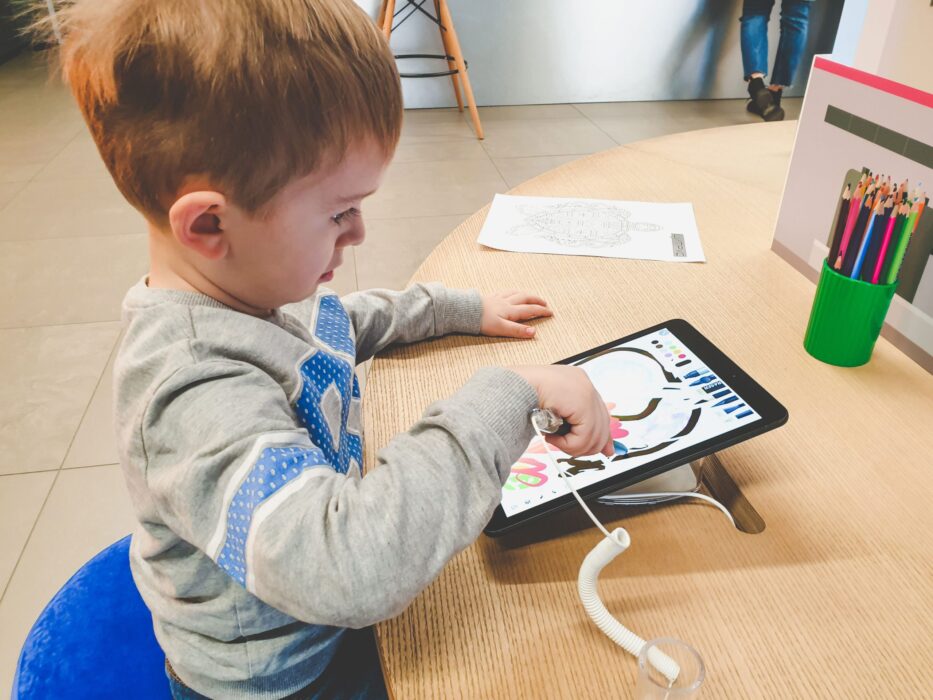Tablets, smartphones, and computers have become staple items in many households, often capturing kids’ attention with engaging and interactive content. The growing use of technology in children’s lives is a trend that shows no signs of slowing down.
As parents, we want to ensure that our children benefit from this digital era in a positive way. Choosing the right apps can play a significant role in fostering creative development. It’s crucial to select applications that are not only fun but also educational, helping our little ones explore their creativity while learning new skills.
This post will guide you through the process of selecting child-friendly apps for creative development. We’ll discuss what to look for in an app, share some top recommendations, and provide tips on how to integrate these digital tools into your child’s daily routine.
The Impact of Technology on Children’s Creativity
Technology, when used wisely, can significantly enhance a child’s creativity. Apps designed for art, music, and storytelling allow children to explore and express their ideas in unique ways. These tools provide endless possibilities, enabling kids to experiment with different mediums and techniques that may not be available offline.
However, the growing use of technology in children’s lives also comes with potential drawbacks. Excessive screen time can lead to reduced physical activity and social interaction. To mitigate these risks, it’s essential to set boundaries and encourage a healthy balance between digital and offline activities. Establishing screen-free zones and times can help maintain this balance.
Experts agree that technology can positively impact creativity if used appropriately. Studies have shown that interactive apps can enhance problem-solving skills and stimulate creative thinking. According to research, children who use educational apps tend to perform better in tasks requiring imagination and innovation. So, selecting the right apps is key.
To make the most of technology, parents should actively participate in their child’s digital activities. Exploring apps together can be a fun and educational experience. Additionally, choosing apps with parental controls can ensure a safe and productive environment, allowing children to benefit from technology without the associated risks.
Criteria for Selecting Child-Friendly Apps
Selecting the right apps involves considering several important factors to ensure they are beneficial and engaging for your child’s creative development. Here are the key criteria to keep in mind.
Age-Appropriateness
Choosing age-appropriate content is crucial for your child’s development. Apps designed for specific age groups ensure that the material is suitable and engaging. Age-inappropriate content can either bore or overwhelm a child, reducing the app’s effectiveness.
To determine age suitability, check the developer’s recommended age range and read app descriptions thoroughly. Preview the app yourself to see if it aligns with your child’s developmental stage.
Age-rating systems and guidelines, such as those from the app stores, provide useful insights. These ratings can help you select apps that are both fun and appropriate for your child’s age.
Educational Value
Apps that enhance creative development through education offer the best of both worlds. Look for features that encourage learning while sparking creativity, such as interactive storytelling or drawing tools.
Educational features might include puzzles, quizzes, and interactive lessons that make learning a playful experience. Apps that combine educational value with creative exploration can keep children engaged longer.
Balancing fun and learning are key. Apps should be entertaining to hold a child’s interest while offering educational benefits. This combination ensures that screen time is productive and enjoyable.
Safety and Privacy
Ensuring safety and protecting privacy are top priorities. Apps should have robust privacy policies, clear data usage terms, and secure logins. Avoid apps that request excessive personal information.
Key privacy features to look for include parental controls, restricted chat functions, and anonymized data usage. These features help keep children safe while they explore creative content.
Resources for app safety reviews, such as Common Sense Media or Privacy Commons, provide detailed analyses of app security features. These reviews can guide you in making informed decisions.
Encouraging Creativity
Apps can foster creativity in various areas like art, music, and storytelling. Select apps that offer tools and prompts to inspire your child’s imagination and creative expression.
Specific app features that encourage creativity include virtual instruments, drawing pads, and storytelling prompts. These tools can help children experiment with different creative mediums.
Insights from educators and child psychologists emphasize the importance of creativity in child development. They recommend apps that allow for open-ended play and creative problem-solving.
User Reviews and Ratings
Checking user reviews and ratings is essential for gauging an app’s quality and reliability. Reviews from other parents can provide valuable insights into an app’s usability and educational value.
Tips for discerning genuine reviews include looking for detailed, specific feedback and checking multiple sources. Avoid reviews that are overly positive or vague, as they may be less trustworthy.
Reliable platforms for app reviews include Common Sense Media, Google Play Store, and Apple App Store. These platforms offer comprehensive user feedback and expert reviews.
Cost and In-App Purchases
Cost considerations for apps are important for managing your budget. Some apps are free, while others require a purchase or subscription. Understand what you’re paying for and whether it’s worth the investment.
Managing in-app purchases with parental controls can prevent unexpected charges. Set up restrictions to ensure that your child doesn’t accidentally buy additional content.
Differences between free, freemium, and paid apps often lie in content availability and advertisements. Free apps might offer basic features with ads, while paid apps usually provide a richer, ad-free experience.
Compatibility
Ensuring app compatibility with devices is crucial to avoid frustration. Check the app’s requirements before downloading to ensure it will run smoothly on your child’s device.
Quick tips for checking compatibility requirements include reading the app description and user reviews. Look for mentions of device performance and any issues with specific models.
Updating the app regularly ensures it remains compatible with the latest device software and benefits from new features and security enhancements. Regular updates can also improve the app’s functionality and user experience.
Integrating Creative Apps Into Daily Routines
Incorporating app use into daily routines can be a seamless way to enhance your child’s creative development. By embedding these activities into everyday schedules, you can create a balanced environment that fosters both digital and offline creativity. This approach ensures that technology becomes a beneficial part of their daily life.
Balancing screen time with other creative activities is essential. Mixing app use with activities like drawing, reading, or playing outside can prevent overreliance on screens. This balance helps children engage in diverse forms of creativity, promoting overall development and reducing the potential negative impacts of excessive screen time.
Parental involvement and monitoring play a crucial role. Using parental controls on platforms like android to select child-friendly apps ensures that the content is appropriate and safe. Actively engaging with your child during their app usage not only enhances the learning experience but also helps you monitor their interaction with technology.
Recommended Child-Friendly Apps for Creative Development
Selecting the right apps can significantly enhance your child’s creative growth. Here are our recommended apps that combine fun and education to foster creativity.
- Toca Life World
- Description: A creative storytelling app where children can explore various worlds, create stories, and interact with different characters.
- Standout Features: Customizable worlds, diverse characters, and endless storytelling possibilities.
- Age Recommendation: 4+
- Draw and Tell by Duck Duck Moose
- Description: An interactive drawing app that allows kids to draw, color, and tell stories using their artwork.
- Standout Features: Variety of drawing tools, animation options, and voice recording.
- Age Recommendation: 3+
- Bandimal
- Description: A fun music creation app that introduces children to making music through animated animal characters.
- Standout Features: Simple interface, playful animal animations, and a range of musical instruments.
- Age Recommendation: 4+
- LEGO DUPLO World
- Description: An educational app that encourages creativity through building and imaginative play with virtual LEGO DUPLO blocks.
- Standout Features: Interactive building experiences, educational games, and problem-solving activities.
- Age Recommendation: 2-5
- Sago Mini World
- Description: A collection of fun and educational mini games that promote creativity and learning through various activities and adventures.
- Standout Features: Diverse mini games, engaging characters, and interactive play.
- Age Recommendation: 2-5
These apps not only provide hours of fun but also encourage children to explore their creative potential in various ways. Each app offers unique features that cater to different aspects of creative development, making them valuable tools in your child’s growth journey.
Conclusion
Selecting child-friendly apps is crucial for fostering creative development in a safe, engaging, and educational manner. By focusing on age-appropriateness, educational value, safety, privacy, creativity, user reviews, cost, and compatibility, parents can ensure their children benefit from technology positively.
Thoughtful app selection can transform screen time into a valuable learning experience. Incorporating apps that balance fun with educational content can help children develop creativity while maintaining their interest. Remember, using parental control to select child-friendly apps adds an extra layer of safety and ensures the content is suitable for your child’s age.
Encouraging parents to engage with apps alongside their children is essential. By exploring these digital tools together, parents can monitor their child’s progress, provide guidance, and share in their creative journey. This involvement not only enhances the learning experience but also strengthens the parent-child bond, making technology a positive part of your family’s routine.





